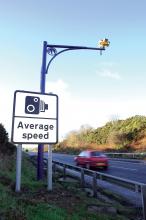Gonzalo García Palacios, R&D engineer with Quality Information Systems, writes about ANPR developments in the Spanish market
In an increasing number of countries, Automatic Number Plate Recognition (ANPR) systems are a growing market. They have become a fundamental part of many ITS systems, whether publicly or privately owned, and essential to any user which looks seriously to give the best services to its customers or wants to improve its facilities' performance.

Over the last few years Spain has seen a huge level of application of ANPR for parking/facilities management and access control
Gonzalo García Palacios, R&D engineer with
Unsurprisingly the greatest potential for market growth is in those countries which currently have an under-developed ANPR sector, because of the unlimited potential to introduce and deploy systems across all types of facilities (highways, toll roads, parking lots and so on). Pioneering markets, such as the UK where ANPR was first developed, have matured to the point where domestic technology manufacturers and suppliers are aggressively pursuing opportunities abroad. Spain ranks among those pioneering markets.
Spanish market history
The Spanish market came into being more than 15 years ago, as a result of the application to the transport and traffic enforcement sector of the latest technologies in electronics, CCDs, computing, cameras and artificial vision techniques.One of the propelling forces of the Spanish ANPR market has been (and remains) the civil service in the forms of various governmental bodies and authorities. The use of ANPR for traffic management and road safety has turned into a continuous reality in the domestic market, where ANPR systems are considered to represent an efficient tool aligned with over-arching policies relating to accident rate reduction and road safety improvement.
The inclusion of mobile ANPR systems, particularly vehicles outfitted with complete ANPR suites, has also become a key factor in public authorities' traffic management strategies - particularly in the major cities, where traffic congestion is becoming a major issue. Mobile ANPR now provides many city councils with a powerful tool with which to clear and regulate traffic jams, illegally or double-parked cars, clear zones, loading and unloading areas, and so on.
It is not just the public sector which has benefited from ANPR's progress, however. Over the last few years there has been a huge level of application for parking/facilities management and access control. Many shopping malls and toll roads have installed ANPR systems. As a result, facility owners and operators have been able to achieve more sophisticated levels of traffic management and greater automation, as well as the attendant improvements in safety, fuel consumption and pollution.
Recent impetus
Although much of this has been going on over the last decade and a half, it is in the last five years in particular that the Spanish ANPR market has undergone accelerated development; indeed, it is fair to say that modern ANPR systems are far removed from older ones both in terms of the market needs they address and the technologies utilised.One of the main reasons for the increase in market demand in Spain is the so-called '40 law' which came into effect in 2002. This law requires all cars parked in parking lots to be identified. Obviously one of the easiest ways to achieve this is the use of an Optical Character Reading (OCR) application which associates a ticket number with a vehicle's registration number and number plates. Almost all parking lot managers have decided to use this solution as a reliable means of identifying vehicles in a way which meets the law's requirements.
Any overview of the Spanish ANPR market would be incomplete without taking a look at the evolution of the technology in Spain. In the same way as Spain and the UK were pioneers in the creation of the first ANPR systems, they have also been closely involved in their technical development. The two countries remain leaders in terms of technological advancement and the supply of the most intelligent and sophisticated solutions.
Technological factors
Technologically speaking, the last few years have been characterised by almost total change. If one compares the most advanced ANPR systems with older-generation equivalents, several key differences are apparent. There has been a move from systems based on PAL cameras with basic LED lighting and single-lane/single-plate OCR to those able to make triggerless multi-plate and multi-lane readings - and which feature advanced LED lighting together with progressive cameras and CCDs, all in complex and interconnected network systems.One of the most striking aspects of ANPR evolution is reading rates. The current high levels have been reached for a complex number of reasons, the main one being the enhancements achieved more recently in artificial vision techniques. These include adaptability to enviromental and lighting conditions, improvements to processing techniques, multi-plate and multi-lane developments, and movement detection as well as some other techniques. The widespread introduction of high-resolution, progressive-scan CCD technology, which involves an increase in the sensor resolution and image quality, is no less important a factor. We have also seen the introduction of Internet Protocol (IP)-based cameras. The use of these has increased massively in the recent past, resulting in large numbers of users becoming capable of networking their entire infrastructures. Last but not least, the development of integrated processing reading units has become common. Despite this we are still in the first stages of real progress in this field. We still need to make powerful 'all-in-one' processing units but we are in fact pretty close to this; we can expect to see solutions emerge in the next few years.
These factors, together with improvements in lighting, have combined to allow us to achieve really good reading rates. These are remarkable in a country like Spain, which suffers from harsh lighting conditions and poor plate quality across the vehicle fleet.
Near-term predictions
So what should we expect to see in the next years? Long-term predictions are risky, if not fanciful, but we can make some fairly accurate predictions for the short- and medium-term.In Spain we actually know, for all the reasons given previously, that the market is highly evolved, deeply rooted in both the public and private sectors,
and mature in the technological sense. All of this places Spanish manufacturers in a highly advantageous position internationally.
In local terms, it is necessary to make advances in traffic and safety policy. Most of the advances will be achieved in this area, rather than through any technological breakthrough (although we can expect the latter to occur as well). Spanish policy has always progressed in this fashion and there is no reason to expect another thing in the short term. Furthermore, there is a drive on the part of the Spanish authorities to maintain and even increase road safety and traffic enforcement levels.
As an example, last November there came into effect a reform in national traffic laws which opens the door to new installations of ANPR cameras at the roadside capable of measuring average, point-to-point speeds. ANPR systems are obviously well suited to this application and in Spain start-up will be pretty much immediate where reading points for such purposes already exist. As noted above, Spanish manufacturers are also ideally positioned to make a real and fast expansion into emerging markets abroad. The know-how, experience and skills in ANPR should lead us to expect this.
Technological trends are more difficult to predict and we can only talk about the short term with any degree of certainty.
At the software level OCR will incorporate multi-lane and multi-plate capabilities as standard. Gradually we should expect new artificial features to make their way into OCR readers; these will include vehicle counting, detection and tracking, and so on. We can also expect, at the hardware level, tighter integration on the reading unit and embedding of OCR readers into cameras, with major increases in processing capacity. Greater system automation, keeping human intervention at a minimum, will become increaingly desirable - especially as users will have to cope with increasing numbers of increasingly complex systems.
Closer integration of and cooperation between ANPR systems and other ITS systems, with online information-sharing taking advantage of IP-based cameras and other networking capabilities which are already available, will be a must for every ITS manufacturer and not just those concerned with ANPR.
ANPR manufacturers should keep pushing to offer new added-value features to their systems, such as: additional integrated, colour images for traffic enforcement: average speed measurement; new artificial vision features; and the gradual incorporation of OCR into other 'classic' ITS systems, as those for red light enforcement.
In summary, Spain has a market that must keep working hard to keep its leading position but at the same time there are plenty of opportunities. In particular, Spanish manufacturers and suppliers need to maintain their tradition of working closely with the relevant authorities in order to continue to deliver to the market innovative and relevant solutions.










